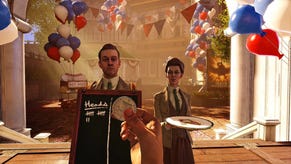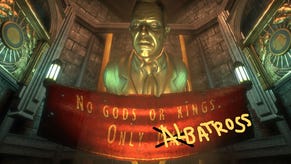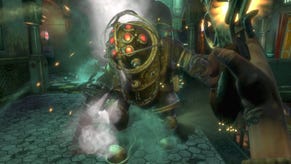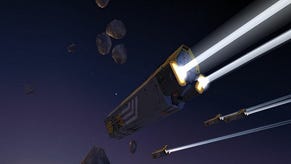Eyes On: BioShock - Infinite
Flying Close To The Sun
We sent Dan Griliopoulos to take a look at BioShock: Infinite. It might have broken him. That's the explanation we have for the opening story. But read on for a super-detailed preview of the third BioShock game, and why Dan suspects it's going to be rather good.
From this side, the sign on the glass door read
"eniveL .G.I
eyE etavirP"The possessor of this inverted moniker was kicked back, brogues pert on the cheap pine desk, face lost somewhere between the loosened tie and tilted fedora, hand trailing towards an errant whiskey glass.
A door far below rattled. Heels chipped at plywood stairs. A customer.
Levine didn't move. But somewhere beneath the hat, sneaking past the week-old stubble and whiskey halitosis, a thought crept in: work? Who'd give him work? Sure, the Ryan job had come off famously, but that was four years back and they'd given the follow-up to goddamn Marin, after all.
The dame came in. She was pure glitz in a 2K-branded jacket and skirt. "We need you, Levine. You give us... cred. The problem's an Era, Levine. It's loose and no-one can capture an era like you. We need a 1900s emotional roller coaster with as many dimensions as you’ve got."
He was flattered, despite himself. They hadn't forgotten! He found himself sitting up, the tumbler abandoned. "Well, sweetcheques, I can do roller coasters. And I can do emotions. Not sure if even I can weld them to multidimensionality though... I might have to call Professor Heisenberg in on this one."
Let me be open; I loved the first Bioshock beyond all reason. I gave the Xbox version 10/10 (for all the right reasons), I went and read Atlas: Shrugged to understand it better, I posited all sorts of pipedreams for sequel cities; Atlantis, Laputa, Zodanga. Yet Bioshock 2, whilst still a good game, whilst mechanically more fun than the original, was also more of a traditional sequel. It didn’t take the original and run with it; it just took it, fixed the combat, extended the plot without altering the world, and added multiplayer. Where the first game was in love with its nascent myth and design, the sequel just loved the franchise. My fervour faded.
As you can tell from the fanfic above, seeing Bioshock Infinite at E3 has changed all that. Either Irrational put something in the E3 kool-aid or the joy of imagination has returned to Bioshock. It’s taken that Laputa twist from Gulliver’s Travels and conjured up a whole other alternate floating world. It has a familiar archaic jump-off point but retains those key Bioshock elements, the fantastic/ridiculous married (in the gameplay and the fiction) with a huge, powerful toolset. Most notable is the implication that, in the name and in the in-game Tears (capitalised to imply rips not boohoos), this is just one of a million parallel Bioshocks.
Summarising, what we know first; you play Booker De Witt, a detective hired to rescue/abduct a girl called Elizabeth. She’s aboard Columbia, a floating World’s Fair designed in 1900 to show the world the glory of America, but which turned violent during the Boxer rebellion and disappeared until 1912. The city itself, when it returns, is split between two factions: the Founders, xenophobic American reactionaries, and the Vox Populi, a fragmented group of levellers and immigrants with hardline communistic elements, and both want control of Elizabeth and her mysterious powers. Until De Witt manages to rescue her, she’s kept locked away by Songbird - a biomechanical winged giant akin to the Big Daddies - who is her gaoler as well as her only friend. Sadly, Elizabeth won’t leave the city until she understands her strange powers better, and De Witt is her unwilling guardian until she will.
The demo we saw took us through several areas newly overrun by the Vox Populi, watching them as they took over an area. There’s elements of it in this teaser trailer:
Beyond this, we got taken through an area overrun by the Vox Populi. Irrational have taken all the classic game behaviour-shaping tools; lighting, structural direction, sound, imagery; and used them to drive people towards the story they want to tell, make you focus on the spots that they’ve poured all their detail into, such as the upcoming curio sho, the adverts on the walls, or the Vox Populi’s troopers. Given the size of the arenas, this replicates and takes advantage of the way that the human eye rests and focuses on particular spots; it's like a magic trick, moving the focus of attention around, so you only see wizardry and not the mechanics underneath.
At this point De Witt and Elizabeth are searching for supplies and a way to Comstock, the leader of the Founders. We stop in at Major’s Sundries, Notions and Novelties, which De Witt laconically describes as a junk shop. The actor playing De Witt channels the perfect pulp detective, straight out of Chandler and Hammett, and what’s notable about this compared to Bioshock is the wealth of dialogue - De Witt and Elizabeth are endlessly chattering, bantering, like the classic His Girl Friday - and this continues once they get inside the curio shop. The shop is packed with junk and, as they’re walking around, Elizabeth plays with the toys, trying on giant Abe Lincoln masks and acting up to the Academy Awards; Booker meanwhile chatters back and grabs ammo, guns, and upgrades (including a vigor called Bucking Bronco, which allows him to fling enemies up and around.)
Suddenly, however, there’s a world-rattling shriek, like a steel ship scraping an iceberg, and they both silently take cover behind the shutters and ornaments. Outside, Songbird’s searchlight-like eye peers in through the window, searching for his lost ward. There’s a tense few moments, then he’s off, hunting elsewhere. Elizabeth’s response to this narrow escape is a little extreme; she asks Booker to kill her rather than ever allow her to go back into captivity, actually placing his hands around her neck.
Outside they find another dying horse, presumably crushed by Songbird’s landing. Elizabeth is traumatised and is determined to save it. She opens a Tear to somewhere/somewhen in which the horse is alive; it attempts to struggle to its feet, but she can’t maintain the rift and it collapses dead again. She tries again, and the rift into yet another world holds for a second longer, then collapses, and the horse with it. Finally, she pushes hard into the air and the Tear holds open into a dark, damp scene, bifurcating the bright world; as she stares in wonderment a huge mechanism speeds towards her and she just manages to shut the tear before it hits. This is all quite astonishing, and either it’s in-engine or perfect enough CGI that I didn’t see the cut.
Quickly, I want to talk Tears. These seem to be rifts into other worlds and times. Not only is that key element introduced slowly - through Elizabeth’s lack of control over her powers - but works right thematically and mechanically in the game, whilst introducing a potential link to the wider Bioshock series. Artistically, inside each Tear is a different world. In the first demo, we heard anachronistic music (Tears For Fears “Everybody Wants To Rule The World”); in the demo we saw, Elizabeth opened a tear to an area with a cinema showing “Revenge of the Jedi”.
Meanwhile, to help De Witt during combat, Elizabeth can actualise one thing from a range of possibilities; she can spirit in cover, turrets and ammo dumps, or create doors leading elsewhere in the level. The options appear like flickering shadows until she chooses one.
(Of course, if the Tears imply that there are an infinite number of parallel universes that Elizabeth can reach into, then there could be universes out there with all the different outcomes from the first game; where any of good Jack, monstrous Jack, Fontaine, Ryan or Tenebaum triumphed. My guess is that this multi-dimensionality is what ultimately links the game’s narrative back to the first two.)
Following this, the duo keep walking through the streets, seeing the dissonance between the publicly-proclaimed morality of the Vox Populi and their thugs’s actions against the unarmed civilians on the street. Around them, are the city’s streets, a hundred architectural styles and pre-World War I posters in joyously saturated colours. A Vox thug approaches and Booker warns him off with a drawn pistol; at any point in this section, Booker can start a fight. Eventually, there’s no choice, which is where he gets to go onto the skyrails.
Here, Booker is attempting to keep Elizabeth safe and get to a zeppelin that’s bombarding the area with rockets. His weaponry is fairly familiar; era guns and the Vigors which have replaced the plasmids from Bioshock (and which appear to have limited uses). He uses the skyrails to get between the different areas of this massively spread-out combat area, gradually riding upwards towards the Zeppelin, all the time talking to Elizabeth and making use of her abilities, as he battles socialists whooping as they ride the rails. Inside the Zeppelin, he triggers a detonation, leaving it sinking flaming to the ground, and plummets back towards the skyrails far below... jarred, he catches one and survives.
Shortly afterwards, Elizabeth and De Witt are trapped in an attic by Songbird; Songbird tears the roof off, knocks Booker down and is about to crush him, when Elizabeth runs up. She agrees to go back with Songbird; he picks her up in a single brassy claw, so that Booker and her have seconds to brush fingertips before she’s gone again. Chasing them to the gaping roof, De Witt leaps out onto the skyrail. And fade.
From everything I saw at E3, Bioshock Infinite was probably my game of the show; I’ll certainly play Skyrim for longer, but I’m certain that I’m going to enjoy this story much more. If you read our interview, you’ll see the hubris they’re showing, calling in Einstein, Heisenberg, and The Devil in the White City for the fiction, but what ultimately seals this for me is that joyous bright design and the charming dialogue between Elizabeth and Booker. I can’t believe that this latter is going to be as organic as it was in the demo we saw; but if it is, PI Levine might find himself in great demand.













